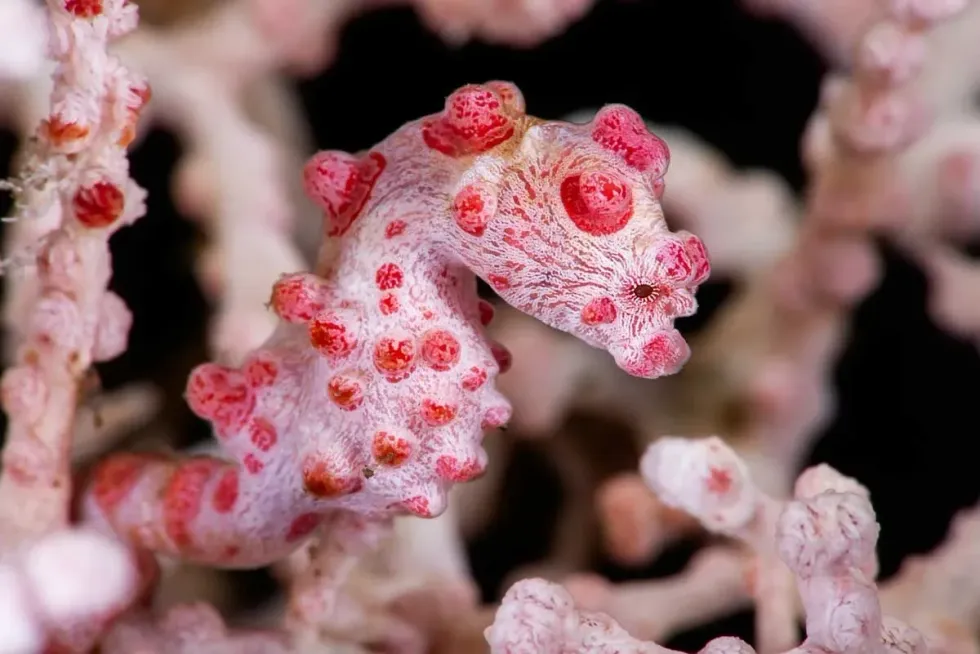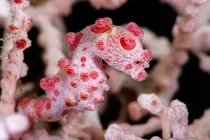If you are looking for some tiny wonders off the coasts of the East Coast of Southeast Asia, then look no further than the seven species of the pygmy seahorse! The pygmy seahorses are tiny fish, distinguished from the dwarf seahorses because of their lack of multiple gill openings, and the presence of a single gill opening.
They also have a brood pouch located in their trunks, which means they rear babies and eat from the same opening!
But do not let their small size fool you!
These animals are some of the most successful hunters off the East Coast of Southeast Asia - even though they are hunted by multiple crustacean species, turtles, lobster, and larger fish. As a result of this, the pygmy seahorse turns to camouflage to survive.
The pygmy seahorses are named such because of the man who discovered them, Georges Bargibant. He accidentally discovered them while searching the corals they lived in.
Talk about a unique coincidence! They were then named the Bargibant's pygmy seahorses the very next year, and since then, it has been only a wild ride for this young species of a pygmy seahorse!
Do you want to know more about these small size animals? then read on, and also check out bonito fish facts and fishfly facts too!
Pygmy Seahorse Interesting Facts
What type of animal is a pygmy seahorse?
Bargibant's pygmy seahorse is a type of seahorse. It is the world's smallest seahorse species, with the seahorses (male) being just as big as 0.55 - 1.06 in (1.4 - 2.7 cm) from the top to the tip of the tail.
What class of animal does a pygmy seahorse belong to?
The soft coral pygmy seahorse belongs to the class of fish and has seven species. These seven species became nine in around 2020 - the rarest of them in and around gorgonian coral.
How many pygmy seahorses are there in the world?
Due to a lack of research, there is no solid data on the population of the species of pygmy seahorse. However, new species of pygmy seahorse are being discovered every year, with the latest one as recent as May 2020 and the first pygmy seahorse was discovered as early as 1969.
Where does a pygmy seahorse live?
This species of pygmy seahorse lives in the ocean, most popularly found in Lord Howe Island Papua New Guinea. Seahorses are usually found 50-150ft (15-40m) deep in the water - and are often confused for dwarf seahorses.
What is a pygmy seahorse's habitat?
The Bargibant's pygmy seahorse species is usually found living among Gorgonian corals (sea fans) and the coral triangle of red sea soft coral (pygmy) around Papua New Guinea, Lord Howe Island, and other places. Though their default color is pink-white, this species of pygmy seahorse can camouflage as per the corals they live in.
These sea fans corals are usually 50-150ft (15-40m) deep, and individual subspecies can go higher or lower as needed.
Who does a pygmy seahorse live with?
The species of pygmy seahorses (Hippocampus satomiae) usually live alone in Gorgonian Coral and another coral reef, except when breeding. In such a case, it is one of the common pygmy seahorse facts they will come together in pairs.
How long does a pygmy seahorse live?
The species of pygmy seahorses live between one to five years. This makes pygmy seahorses one of the least long lives members of the seahorse family. In fact, even the marlin has a longer lifespan than the pygmy seahorses.
How do they reproduce?
The female transfers the unfertilized eggs to the brood pouch of the male seahorse, wherein he fertilizes the eggs. The male then gives birth to live babies in under a month. However, the brood pouch of the seahorses is not located on the back of their bodies.
What is their conservation status?
Though the IUCN List marks this species as Data Deficient, scientists warn that this may not be the case if the seas continue changing with acidification of the coral reefs and temperature changes. In fact, many other animals, like the lobster, face extinction due to marine changes.
Pygmy Seahorse Fun Facts
What do pygmy seahorses look like?

Many species of pygmy seahorses range around 0.55 - 1.06 in (1.4 - 2.7 cm) in length from the top to the tip of the tail.
Pygmy seahorse has a single gill opening instead of multiple gill openings located on the back of the head. They have a brood pouch, not on their bellies but instead practice trunk brooding, which means that they have a brood pouch located in their trunk, which differentiates them from true pygmy seahorses.
Though this fish will normally be pink-white shade (due to their habitat), they can also change colors to camouflage and hide their young (especially Coleman's pygmy seahorse.)
How cute are they?
Not only are they small and adorable, but their large eyes and pretty colors are also enough to woo anyone! However, even if you do see one deep dividing off the South East Asian coasts, be careful not to touch them! They can be injured very easily.
How do they communicate?
Pygmy seahorses are entirely non-verbal, which means most of their communication happens through physical cues and chemicals. They do not possess vocal cords, but only basic organs needed for optimal functioning.
How big is a pygmy seahorse?
The biggest pygmy seahorse size comes at 0.51 in (1.29 cm), which is almost 10 times smaller than the big-bellied seahorse, the biggest seahorse coming in at an impressive 14 in (35.56 cm) at full length.
This means that while the pygmy seahorse would just barely fit on a single digit, the biggest seahorse, however, would definitely be one to handle!
How fast can a pygmy seahorse move?
Do not be fooled by their tiny sizes! The male pygmy seahorse can move up to 500 body lengths in just one second.
This is almost 6.5 mph (10kph) for an average adult! This makes them one of the best swimmers in the ocean, which comes in handy when they chase prey or escape predators. In fact, they will also latch onto smaller debris with their tails to ride the ocean current.
How much does a pygmy seahorse weigh?
Due to their fragile bodies and minuscule weight, it has been impossible to weigh the pygmy seahorse. However, estimates have compared their weight to that of some rice grains. Talk about being a lightweight creature!
What are the male and female names of the species?
There is no particular name for the male and female of the species. In seahorses, both sexes carry the birth of pregnancy, with the male seahorse carrying the babies to term, as well as fertilizing the eggs.
What would you call a baby pygmy seahorse?
There is no specific name one uses to refer to the young of this species. The young are born within 24-26 days. The young of this species also learn their behavioral cues from the male pygmy (who give birth to them), and who they follow for two weeks before leaving on their own.
What do they eat?
Pygmy seahorses eat small crustaceans. They are small, shrimp-like creatures who also live on the same corals frequented by pygmy seahorses.
They suck their prey in with their tubular mouth openings and have to keep eating frequently. This is because they lose a lot of energy keeping up with ocean currents, and will die if they do not feed for one day.
Are they poisonous?
No, they pose no danger to humans. They are too small to even attempt to hurt humans.
However, humans should be careful not to touch them, because their bodies are fragile enough to break at even the slightest human touch. This has also been a major barrier to scientific research into them, because they have to be handled with care not many are capable of carrying out.
Would they make a good pet?
No, the pygmy seahorse would not make a very good pet. Not only do we not know enough about them (since they were discovered only in 2011), they are also not suited to captivity, which drastically decreases their lifespan.
Did you know...
The pygmy seahorse is considered a deadlier killer than the great white shark! The great white has a kill rate of a little under 50%.
This means that only half of its attempts to capture prey succeed. However, the pygmy seahorse has a tubular mouth to suck things in, as well as a body designed to move through the water silently. This makes their kill rate more than 90%, making them far more successful predators.
Why do pygmy seahorses camouflage?
Pygmy seahorses are very fragile and small, and will not be able to protect themselves from pygmy seahorse predators. This is one of the biggest reasons that they camouflage.
A lot of their prey also lives in the same corals where they hide, making their camouflage a good way to get close to them without the prey knowing. Since they already have very speedy swimming speeds, they will have a successful hunt every time they go out.
How many types of seahorses are there?
There are up to 47 different types of seahorse species all across the world. Of this, nine species are of the pygmy seahorse, the most recent of which was discovered in May 2020 off the Japanese coast.
The nine pygmy seahorse Species are Bargibant's pygmy seahorse (Hippocampus bargibanti), Denise's pygmy seahorse (Hippocampus denise), Pontoh's pygmy seahorse (Hippocampus pontohi), Satomi's pygmy seahorse (Hippocampus satomiae), Severn's pygmy seahorse(Hippocampus severnsi), Walea soft coral pygmy seahorse(Hippocampus waleananus), Coleman's pygmy seahorse (Hippocampus colemani), Japanese pygmy seahorse (Hippocampus japapigu), and the most recently discovered, the Sodwana pygmy seahorse.
They are mostly found in and around South East Asian coasts, spotted around Japan in particular, making it a hotspot for anyone who wishes to visit these small yet wonderful creatures. However, if you do see a herd, make sure you do not get too close!
Here at Kidadl, we have carefully created lots of interesting family-friendly animal facts for everyone to discover! Learn more about some other animals from our Pacific salmon facts and herring facts pages.
You can even occupy yourself at home by coloring in one of our free printable pygmy seahorse coloring pages.







